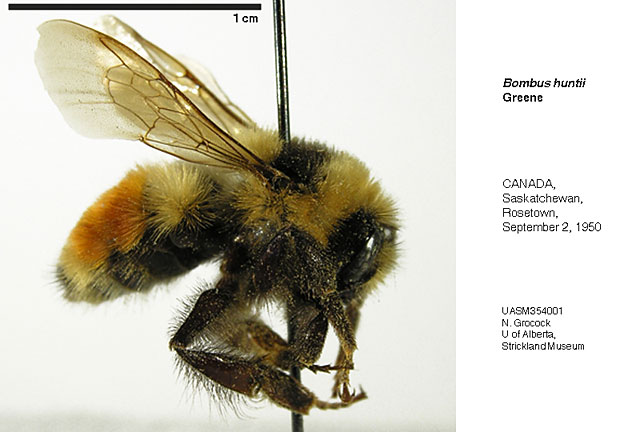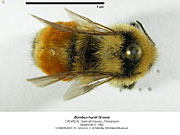Species Details
Bombus huntii
University of Alberta E.H. Strickland Entomological Museum Read more about this collection »
SeasonalityQueens fly from late March to late September, workers from late May to early October, and males from late May to late October (Thorp et al., 1983).
IdentificationBombus huntii belongs to the subgenus Pyrobombus, which is characterized by antennal flagella 2.5 to 3 times longer than the scape, and by the malar space, the area from the bottom of the compound eye to the base of the mandible, which is less than twice as long as it is wide (Thorp et al., 1983). Males are distinguished by penis valves that are apically recurved inwards or are hook-shaped. The body of B. huntii is covered in dense, medium length pile (Franklin, 1912). In males, the face, occiput, and cheeks are covered in yellow pile, whereas females have black cheeks. The thorax is mainly yellow, with a black band between the wings that has a nearly straight rear margin. Segments one and four of the abdomen are yellow, two and three are ferruginous red, and the remaining two segments, five and six, are black; however, black hairs may be admixed throughout the abdomen. The wings of the queen are strongly brown, while workers and males wings are lighter coloured and are typically subhyaline. Body length and wingspan differs between castes: queens are 14 to 19 mm in length with a wingspan of 36 to 37 mm, workers range in length from 9 to 13 mm with a wingspan of 20 to 28 mm, and male body length is from 11 to 12 mm with a wingspan from 25 to 27 mm.
Scientific Name
Bombus huntii
Habitat
Mixed prairie habitats with underground nests (Hobbs, 1967). Surface nests not commonly utilized.
Seasonality
Queens fly from late March to late September, workers from late May to early October, and males from late May to late October (Thorp et al., 1983).
Identification
Bombus huntii belongs to the subgenus Pyrobombus, which is characterized by antennal flagella 2.5 to 3 times longer than the scape, and by the malar space, the area from the bottom of the compound eye to the base of…
Bombus huntii belongs to the subgenus Pyrobombus, which is characterized by antennal flagella 2.5 to 3 times longer than the scape, and by the malar space, the area from the bottom of the compound eye to the base of the mandible, which is less than twice as long as it is wide (Thorp et al., 1983). Males are distinguished by penis valves that are apically recurved inwards or are hook-shaped. The body of B. huntii is covered in dense, medium length pile (Franklin, 1912). In males, the face, occiput, and cheeks are covered in yellow pile, whereas females have black cheeks. The thorax is mainly yellow, with a black band between the wings that has a nearly straight rear margin. Segments one and four of the abdomen are yellow, two and three are ferruginous red, and the remaining two segments, five and six, are black; however, black hairs may be admixed throughout the abdomen. The wings of the queen are strongly brown, while workers and males wings are lighter coloured and are typically subhyaline. Body length and wingspan differs between castes: queens are 14 to 19 mm in length with a wingspan of 36 to 37 mm, workers range in length from 9 to 13 mm with a wingspan of 20 to 28 mm, and male body length is from 11 to 12 mm with a wingspan from 25 to 27 mm.
Life History
This account is synthesized from Alford (1975) and Hobbs (1967). Newly mated Bombus huntii queens are among the first species of Bombus to emerge from overwintering and establish nests in mixed prairies. Nest sites…
This account is synthesized from Alford (1975) and Hobbs (1967). Newly mated Bombus huntii queens are among the first species of Bombus to emerge from overwintering and establish nests in mixed prairies. Nest sites are often created in abandoned nests of small mammals such as shrews, mice, and voles. Some queens disguise tunnel entrances, using grasses and soil, before creating the brood chamber. The queen then makes several foraging trips to collect pollen and nectar which she uses to form the brood clump and honeypot. Pyrobombus queens mold pollen into two, three, or four egg cells, and deposit an egg in each. She then uses her mandibles to manipulate the pollen and encloses the eggs in the cell. Soon after, the queen secretes a wax covering over the cells, which mixes with the pollen. The larvae that hatch consume the pollen from the egg cells, and the queen provides each with additional pollen and honey. Usually, after a period of four to five weeks, the first workers emerge from cocoons and assume the roles of foraging and caring for the succeeding broods, while the queen strictly creates egg cells and lays eggs. Workers help to maintain the colony at the ideal temperature of 32°C by conducting incubation bouts at low ambient temperatures, and by wing fanning to cool the colony at high temperatures (Gardner et al., 2007). The queen reuses wax and pollen to form new egg cells, which are created in straight lines over the cocoons. Egg cells are typically primed with pollen, which is tamped down before eggs are laid, and the cells are capped. Bombus huntii is the only species, in Alberta, that has been observed laying eggs on pollen cylinders. Males are typically reared before young queens and will leave the hive in search of mates. Queens are produced when the colony has sufficient levels of food to feed the brood, which is not dependant on colony size alone. Male B. huntii have exclusively been observed copulating with queens outside of the hive, typically on the wing.
Conservation
Worldwide reductions in Bombus species have been documented in multiple studies, sparking concern for the sustainability of bumblebees, which are important pollinators (Li et al., 2011). Li et al. (2011) also found…
Worldwide reductions in Bombus species have been documented in multiple studies, sparking concern for the sustainability of bumblebees, which are important pollinators (Li et al., 2011). Li et al. (2011) also found that both wild and lab-reared Bombus huntii are infected by deformed wing virus, which is another negative factor impacting the species. However, nearly four-fifths of North American bumblebee species are globally secure and B. huntii are categorized as the most secure (Schweitzer et al., 2012). The IUCN lists B. huntii as a species of least concern, and states that the population trend is stable.
Diet Info
Adults are polylectic and consume pollen and nectar from 37 genera in 18 families of flowers, including: Leguminosae, Saxifragaceae, Compositae, and Scrophulariaceae (Thorp et al., 1983).
Range
Nearctic distribution (Thorp et al., 1983). West of 100° longitude, from southern Saskatchewan, to northern Chihuahua, Mexico, and west to southern British Columbia, down to eastern California, USA.
Publications
Author
Schweitzer, D. F., Capuano, N. A., Young, B. E., & Colla, S. R.
Title
Conservation and Management of North American Bumble Bees
Publication Date
2012
Author
Li, J., Peng, W., Wu, J., Strange, J. P., Boncristiani, H., & Chen, Y.
Title
Cross-species infection of deformed wing virus poses a new threat to pollinator conservation.
Publication Date
2011
Series Title
Journal of Economic Entomology
Volume
104
Pages
732-739
Author
Gardner, K. E., Foster, R. L., & O’Donnell, S.
Title
Experimental analysis of worker division of labor in bumblebee nest thermoregulation (Bombus huntii, Hymenoptera: Apidae).
Publication Date
2007
Series Title
Behavioral Ecology and Sociobiology
Volume
61
Pages
783-792
Author
Thorp, R. W., D. S. Horning Jr. and L. L. Dunning
Title
Bumble bees and cuckoo bumble bees of California (Hymenoptera: Apidae).
Publication Date
1983
Series Title
Bulletin of the California Insect Survey
Volume
23
Pages
viii + 79 pp.
Author
Alford, D. V.
Title
Bumblebees.
Publication Date
1975
Pages
352
Author
Hobbs G. A.
Title
Ecology of species of Bombus Latr. (Hymenoptera, Apidae) in southern Alberta. VI. Subgenus Pyrobombus.
Publication Date
1967
Series Title
The Canadian Entomologist
Volume
99
Pages
1271-1292
Author
Franklin H. J.
Title
The Bombidae of the New World, part I.
Publication Date
1912
Series Title
Transactions of the American Entomological Society
Volume
38
Pages
177– 486
Title
IUCN Red List of Threatened Species
Series Title
Ecology
Specimen Information
There are 36 specimens of this Species.
UASM354001 - Bombus huntii
University of Alberta E.H. Strickland Entomological Museum
Place CollectedCanada: Saskatchewan, Rosetown
Collected ByPeterson, L. K.
Date Collected1950-09-02
UASM354009 - Bombus huntii
University of Alberta E.H. Strickland Entomological Museum
Place CollectedCanada: Alberta, Lethbridge
Collected ByLarson, D.
Date Collected1960-07-20
UASM354010 - Bombus huntii
University of Alberta E.H. Strickland Entomological Museum
Place CollectedCanada: Alberta, Lethbridge
Collected ByLarson, D.
Date Collected1959-06-23
UASM354011 - Bombus huntii
University of Alberta E.H. Strickland Entomological Museum
Place CollectedCanada: Alberta, Scandia
Collected ByLilly, C. E.
Date Collected1950-08-30
UASM354012 - Bombus huntii
University of Alberta E.H. Strickland Entomological Museum
Place CollectedCanada: Alberta, George Lake
Date Collected1965-06-22
UASM354013 - Bombus huntii
University of Alberta E.H. Strickland Entomological Museum
Place CollectedCanada: Alberta, Edmonton
Collected BySkirving, M. A.
Date Collected1966-06-16
UASM354014 - Bombus huntii
University of Alberta E.H. Strickland Entomological Museum
Place CollectedCanada: Alberta, Scandia
Collected ByLilly, C. E.
Date Collected1950-08-30
UASM354015 - Bombus huntii
University of Alberta E.H. Strickland Entomological Museum
Place CollectedCanada: Alberta, Edmonton
Collected ByWatt, H. D.
Date Collected1957-07
UASM354016 - Bombus huntii
University of Alberta E.H. Strickland Entomological Museum
Place CollectedCanada: Saskatchewan, Alsask
Collected ByLilly, C. E.
Date Collected1950-04-05
UASM354017 - Bombus huntii
University of Alberta E.H. Strickland Entomological Museum
Place CollectedCanada: Alberta, Vauxhall
Collected ByLilly, C. E.
Date Collected1950-08-29
UASM354018 - Bombus huntii
University of Alberta E.H. Strickland Entomological Museum
Place CollectedCanada: Alberta, Lethbridge
Collected ByLilly, C. E.
Date Collected1950-08-28
UASM354019 - Bombus huntii
University of Alberta E.H. Strickland Entomological Museum
Place CollectedCanada: Alberta, Opal
Collected ByHocking, B.
Date Collected1955-08-09
UASM354020 - Bombus huntii
University of Alberta E.H. Strickland Entomological Museum
Place CollectedCanada: Alberta, Lethbridge
Collected ByLilly, C. E.
Date Collected1950-08-28
UASM354021 - Bombus huntii
University of Alberta E.H. Strickland Entomological Museum
Place CollectedCanada: Alberta, Vauxhall
Collected ByLilly, C. E.
Date Collected1950-08-29
UASM354022 - Bombus huntii
University of Alberta E.H. Strickland Entomological Museum
Place CollectedCanada: Alberta, Scandia
Collected ByLilly, C. E.
Date Collected1950-08-30
UASM354023 - Bombus huntii
University of Alberta E.H. Strickland Entomological Museum
Place CollectedCanada: Saskatchewan, Rosetown
Collected ByPeterson, L. K.
Date Collected1950-09-03
UASM354024 - Bombus huntii
University of Alberta E.H. Strickland Entomological Museum
Place CollectedCanada: Alberta, Lethbridge
Collected ByLilly, C. E.
Date Collected1947-08-26
UASM354025 - Bombus huntii
University of Alberta E.H. Strickland Entomological Museum
Place CollectedCanada: Alberta, Glenwood
Collected ByLilly, C. E.
Date Collected1950-02/1950-09
UASM354026 - Bombus huntii
University of Alberta E.H. Strickland Entomological Museum
Place CollectedCanada: Alberta, Lethbridge
Collected ByLilly, C. E.
Date Collected1950-08-17
UASM354027 - Bombus huntii
University of Alberta E.H. Strickland Entomological Museum
Place CollectedCanada: Alberta, Mercoal
Collected ByBrowett, R.
Date Collected1957-07
UASM354028 - Bombus huntii
University of Alberta E.H. Strickland Entomological Museum
Place CollectedCanada: Alberta, Edmonton
Collected ByKenakin, L.
Date Collected1963-08-28



